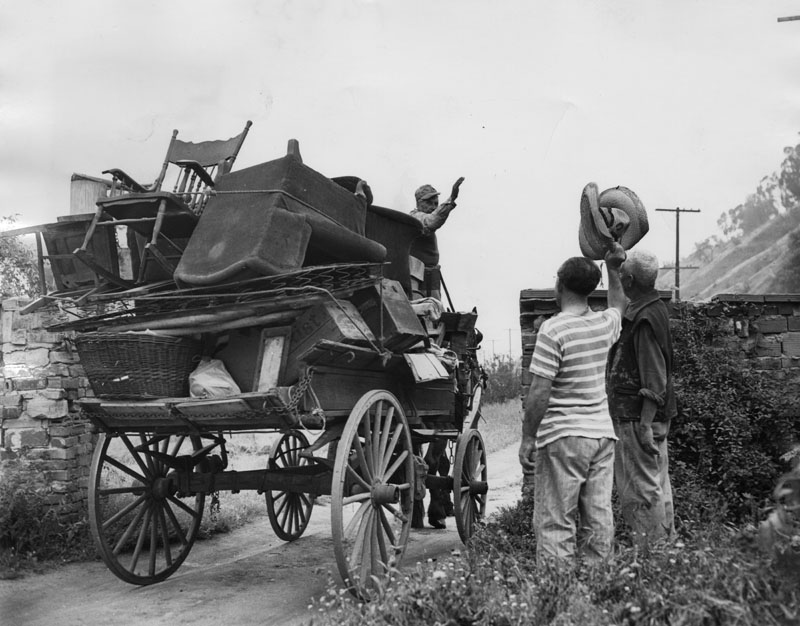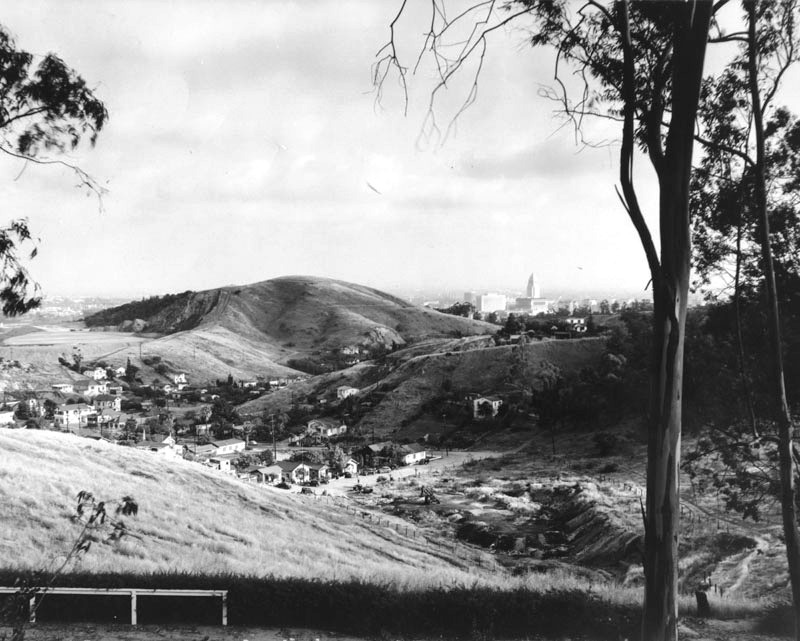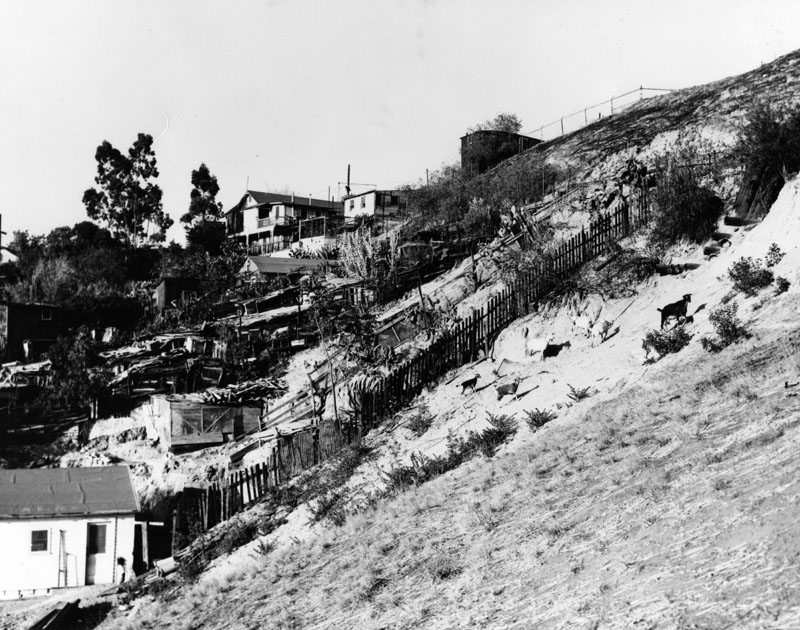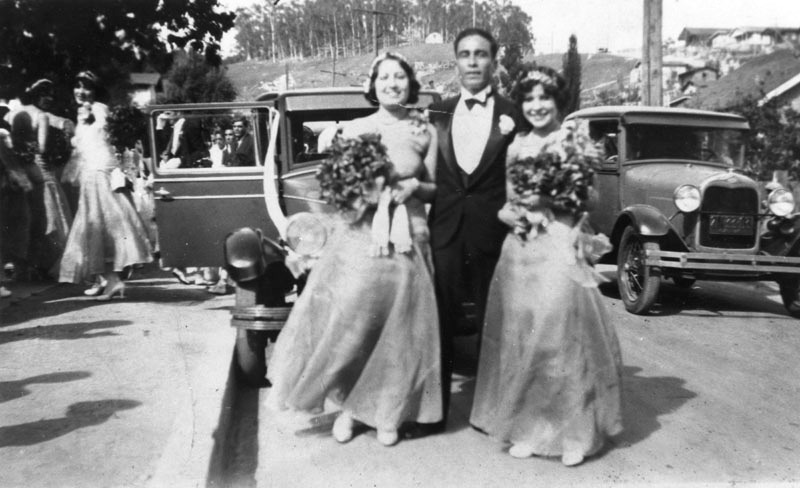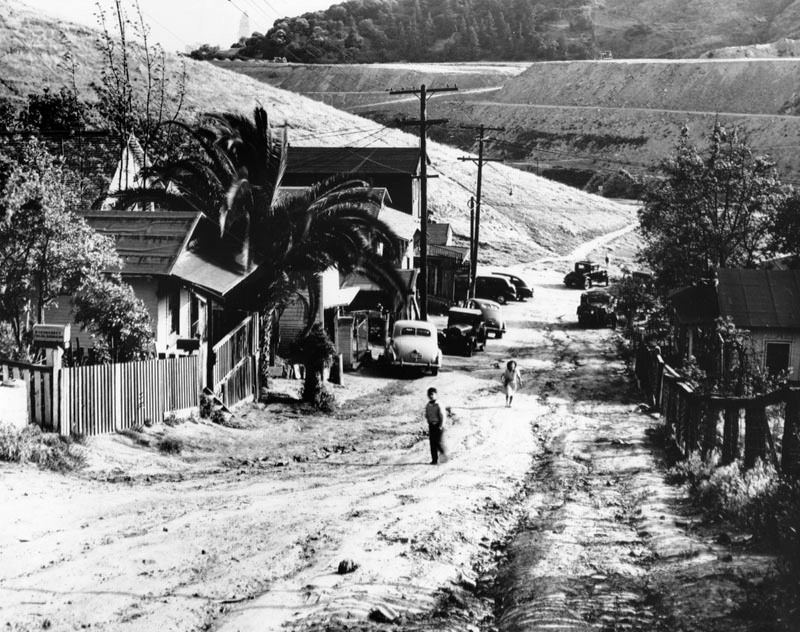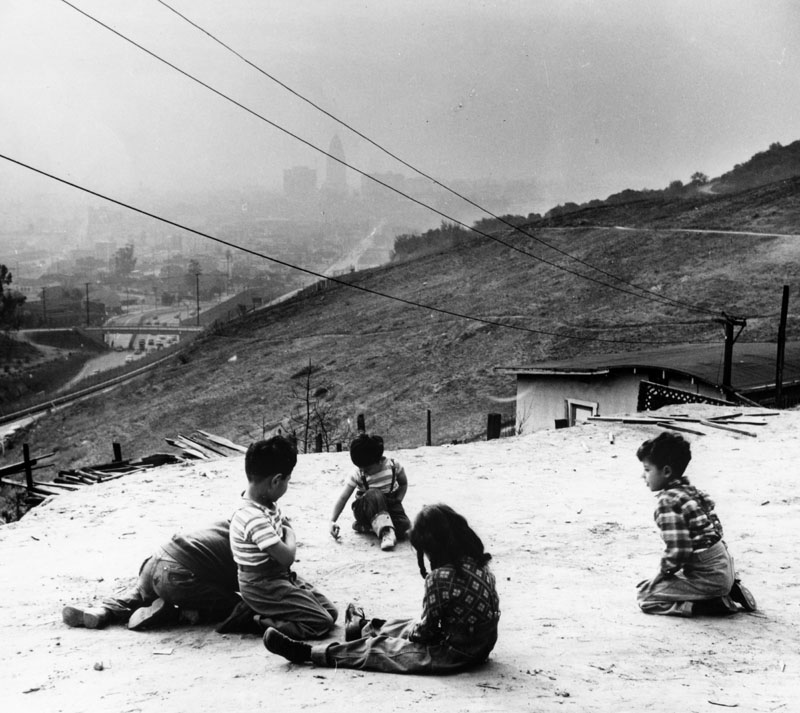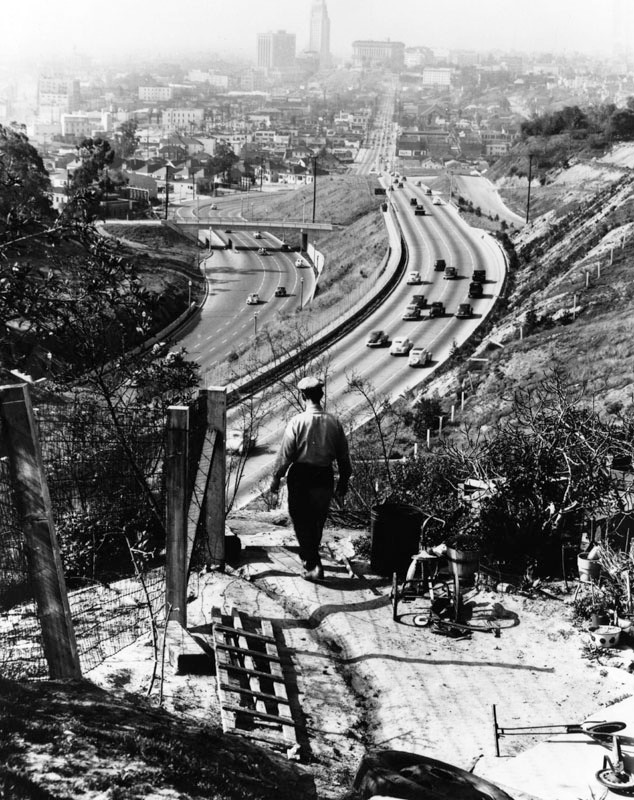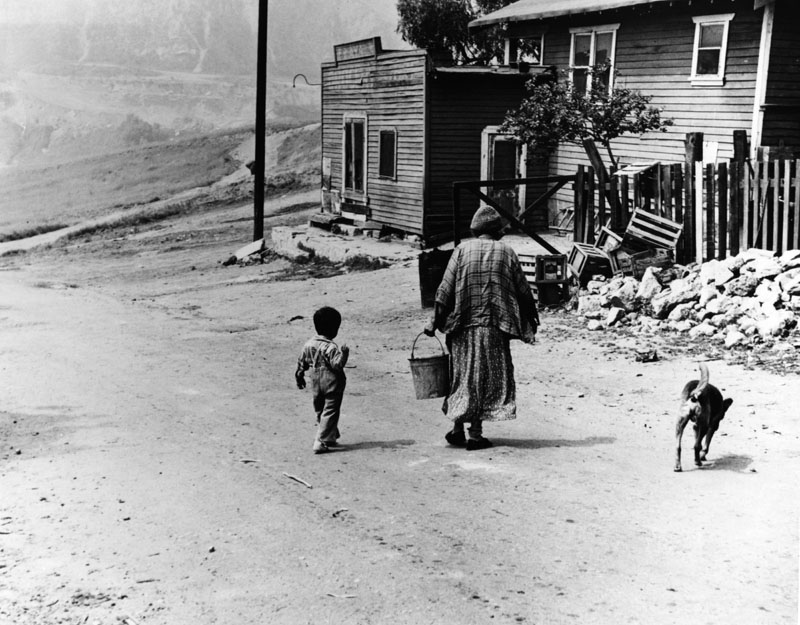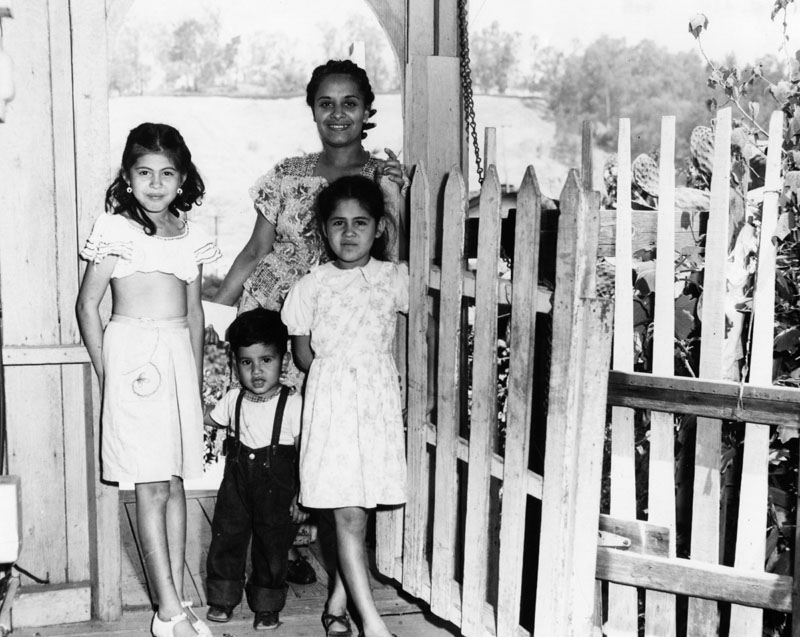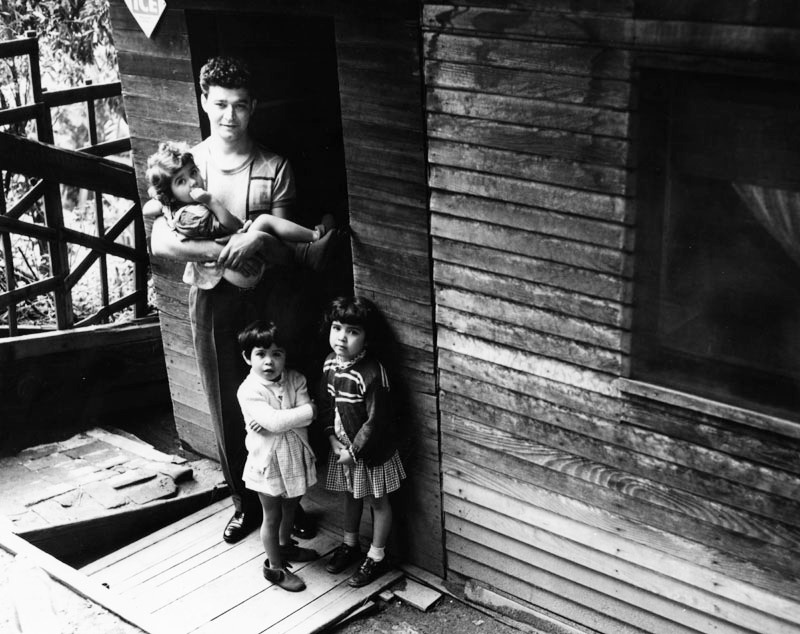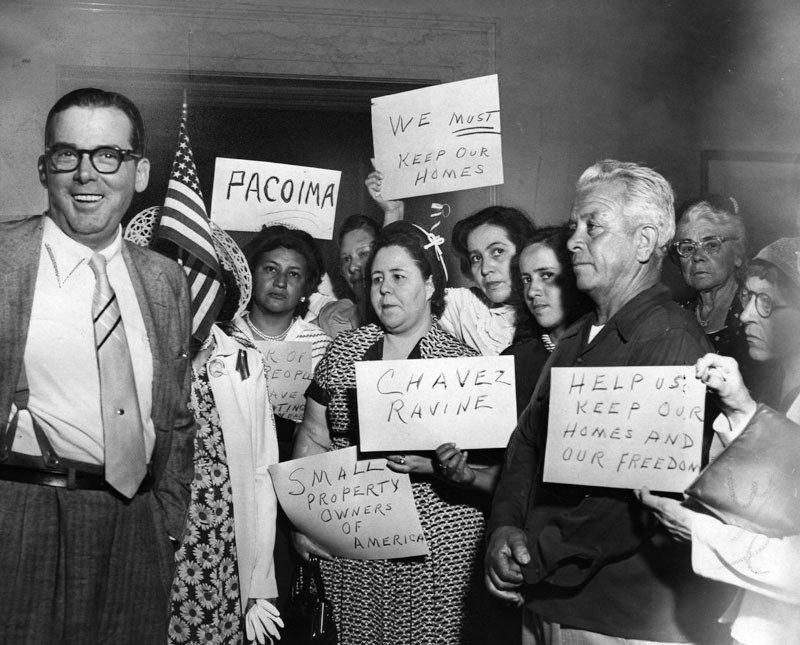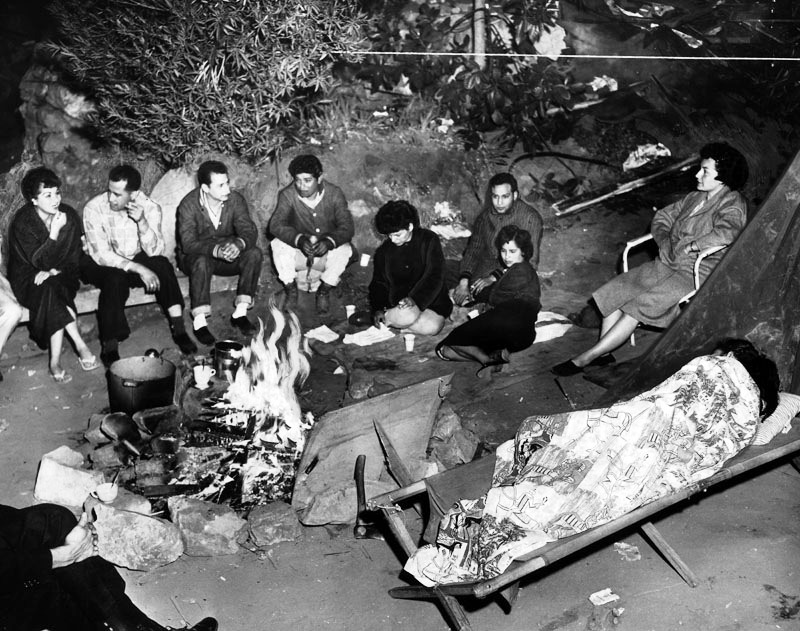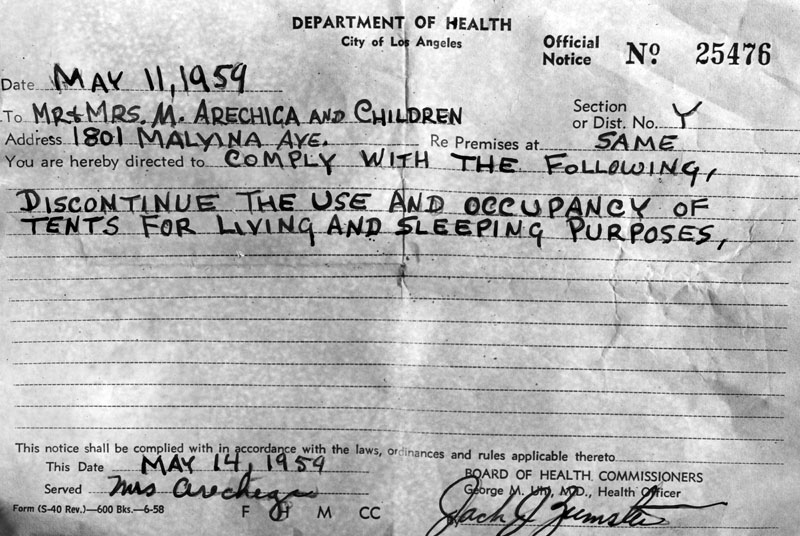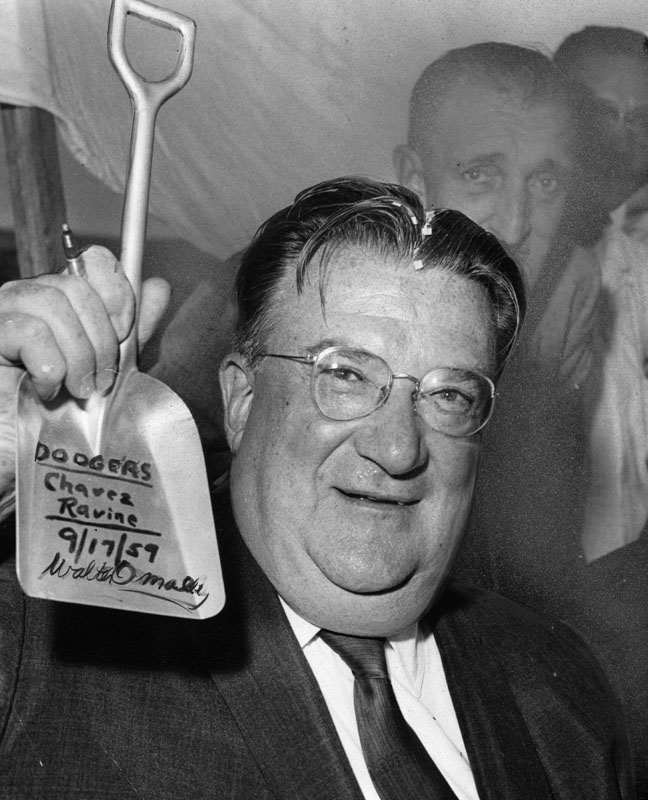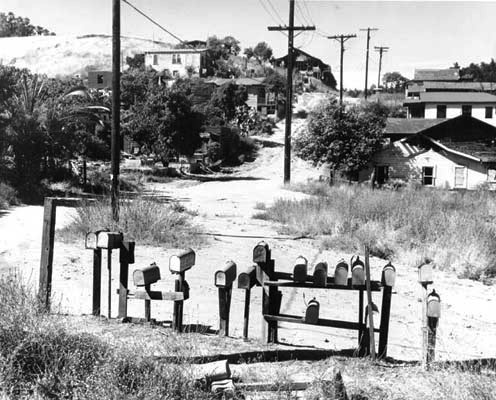Housing Authority Collection, Image #00031398, 1952. Leonard Nadel, photographer.
Once upon a time there was a Los Angeles area called Chávez Ravine, a tightly knit group of three small neighborhoods made up largely of Mexican-Americans families and a few Caucasian bachelors. They farmed garden plots, raised chickens and goats, shopped at a local bodega, and attended mass at at Santo Niño Church. There was a tortilleria and a woman who sold nopalitos. The children attended nearby Palo Verde Elementary School.
Goats grazed on the hillsides.
We raised chickens, rabbits, goats. We used to take the goats up the hill when the mama goat had little babies, so they could run around. We’d take formula in a bottle with a nipple and we fed them in the hills. We had a lot of good times. (Sally Anchondo)
Housing Authority Collection, Image #00033673, 1950. Leonard Nadel, photographer.
Weddings were celebrated.
When I got married I walked all that street of La Loma in my bridal gown and veil. I was an outsider, but it was like a family. Everybody came to the wedding. Everybody ate. They all knew each other. That night I was so tired I went into the home of one of his aunts. The women helped me with my dress and put me to bed so I could rest for the dance. And when they were looking for me, “Where’s the bride?” She was asleep in the house of someone she didn’t even know! That’s how people were. (Delia Aguilar)
Bridesmaids and best man at a wedding party in Chávez Ravine, Shade of L.A.: Mexican American Community, Image #00002754, 1929.
Children played in the dirt streets.
Housing Authority Collection, Image #00033695, 1950. Leonard Nadel, photographer.
It shows the way we used to live. Kids nowadays, they wouldn’t let them play like that. People were rougher then, even the kids. (Reyes Guerra)
Housing Authority Collection, Image #00033702, 1949. Don Normark, photographer.
The neighborhood overlooked, and was overlooked by, downtown Los Angeles, one mile to the south.
Housing Authority Collection, Image #00008229, 1949. Don Normark, photographer.
View Finders
Chávez Ravine found itself in the eye of the photographer several times for a variety of reasons.
Gilbert Rosales and his grandmother, Doña Martina Ayala, head to the family store where she sold chickens, home-made Mexican cheese, beans, and household essentials. Housing Authority Collection, Image #00033701, 1949. Don Normark, photographer.
Don Normark (1928-2014) stumbled onto the communities of Chávez Ravine in 1949 as a young photography student:
I was looking for a high point to get a postcard view of Los Angeles. I didn’t find that view, but when I looked over the other side of the hill I was standing on, I saw a village I never knew was there. Hiking down into it, I began to think I had a found a poor man’s Shangri-la. It was mostly Mexican and certainly poor, but I sensed a unity to the place, and it was peacefully remote. The people seemed like refugees — people superior to the circumstances they were living in. I liked them and stayed to photograph. I didn’t know it at the time, but I was in Chávez Ravine. (Don Normark)
Of Normark’s hundreds of photos, five were displayed in a1950 exhibit at the Los Angeles County Museum of Art. A few made their way into the files of the Housing Authority of the City of Los Angeles (HACLA). The rest were largely forgotten for many decades
In the mid-1990s, Normark returned to Los Angeles, this time seeing out the desterrados (the uprooted) from Chávez Ravine and collecting memories spurred by his photographs. The result was a 1999 book and a 2004 documentary narrated by Cheech Marin, both titled Chávez Ravine: A Los Angeles Story. In 2013 his photographs were included in an exhibit at the J. Paul Getty Museum titled “Overdrive: L.A. Constructs the Future, 1940-1990.”
The Navarro family, Housing Authority Collection, Image #00033696, 1951. Leonard Nadel, photographer.
Leonard Nadel (1916-1990), a freelance photographer and journalist, was hired by HACLA in the late 1940s to document neighborhoods under consideration for housing projects. In the years 1950 to 1952, just on the heels of Normark, his work brought him to the neighborhoods that made up Chávez Ravine where he photographed both the structures and the people. Nadel went on to some fame documenting the Bracero Program for the Ford Foundation. His photos were featured in a 2009-2010 exhibit at the National Museum of American History titled ” Bittersweet Harvest.”
It should be noted that HACLA used the photos of both Nadel and Normark to promote its agenda — captioning them with buzzwords such as “slum,” “derelict,” “country-like,” “run-down,” and “ramshackle.”
Veteran William Nickolas with three of his six children in a home he and his wife share with her parents. Housing Authority Collection, Image #00062033, n.d. Leonard Nadel, photographer.
Residents of several low-income communities meet with L.A. Mayor Norris Paulson (at left) urging him to reverse the plans of the housing authority to raze their homes. In fact, Mayor Paulson worked to scale back the plans for housing projects, but too late to save Chávez Ravine. Herald-Examiner Collection, Image #00055873, July 20, 1953.
Remove and Replace
The post-war urban planning models called for slums to be cleared and replaced with planned communities of towers and garden apartments. The well-intentioned proposals of the urban planners often faced off against established, if indeed ramshackle, communities. The fight between social reformers and advocates of the status quo is one that continues today.
In July 1950 HACLA announced plans to build several housing projects in neighborhoods throughout the city, including Chávez Ravine. The 300-plus families inhabiting the hillsides were mailed notices, in English, informing them that they would need to sell their properties to the city or they would be taken by eminent domain. They were told they would be first in line for the new units once built.
Most families chose to comply after some initial protests proved ineffectual. People packed up and moved out; bulldozers moved in. By 1953 only a couple of dozen families remained on the dusty hillsides.
A man identified as “Julian” bids farewell to his friends in Chávez Ravine. Herald-Examiner Collection, Image #00041360, May 14, 1951.
The Hold-outs
But things were not so simple. Over the next several years plans for model subsidized housing faced a backlash from social conservatives, who, in the McCarthy Era, saw “creeping socialism” in them. Ultimately, housing projects across the city were scaled back and the plans for Chávez Ravine scrapped.
But the city still owned the bulk of the land. The death-knell for the dying community came in 1959 when the city handed the area over to the Brooklyn Dodgers for a new baseball stadium in a complicated business deal which brought the team to Los Angeles. The last few families in Chávez Ravine were sent eviction notices. Even then, a few tried to hold out. Led by the Arechiga family, they vowed to fight to the bitter end, leading to a field day for area reporters and photographers who sensed a cause célèbre.
On Friday, May 8, (“Ocho de Mayo“), residents, along with their pets and belongings, were roughly removed from their dwellings as TV cameras rolled and cameras snapped. Even as bulldozers arrived to level the remaining homes, a number of neighbors camped out in makeshift tents from where they had to be evicted a second time. The story was picked up by the A.P. wire service under the headline “Dodger Victims.”
L.A. County Sheriff personnel carry Aurora Vargas-Arechiga from her home, May 8, 1959. Herald-Examiner Collection, Image #00041424.
News crews thronged the hill to document the eviction. Note the doghouse from where the Arechiga’s chihuahua was evicted. Herald-Examiner Collection, Image #00041423, May 8, 1959.
Members of the extended Arechiga family and supporters camped out on the property for a number of days following eviction. Herald-Examiner Collection, Image #00050956, May 8, 1959.
After leaving, it was sad going back to visit. There were fewer and fewer places. Bulldozers working and trucks hauling stuff away. Weeds growing, streets going to hell. Abrana Arechiga, still holding out, would yell at us out her window, “What are you doing here? You abandoned us.” (Lou Santillan)
Herald-Examiner Collection, Image #00081495, 1959.
Fade-out
Today the tale of Chávez Ravine is seen as a classic case of “urban removal,” albeit one with a twist. Four months following the final evictions, a groundbreaking was held, not for new housing but for a 23-million dollar stadium. As the hillsides were leveled for the stadium, nothing was left of the communities that had once occupied the land; even the street names were erased, the school building buried under tons of fill. Only the name, Chávez Ravine, survives as an access road to the stadium and in an occasional dateline about baseball.
Dodgers owner Walt O’Malley displays a ceremonial groundbreaking shovel with the words “Dodgers: Chávez Ravine.” Herald-Examiner Collection, #00055863, 1959.
Housing Authority Collection, Image #00017632, 1952. Leonard Nadel, photographer.
Selected sources
All quotations taken from Dan Normark, Chávez Ravine, 1949: A Los Angeles Story (San Francisco: Chronicle Books, 1999).
“Chávez Ravine: A Los Angeles Story,” video produced by Jordan Mechner, Bullfrog Films, 2004.
Elaine Woo, “Don Normark, who photographed Chávez Ravine residents, dies at 86,” Los Angeles Times, June 11, 2014.
Nathan Masters, “Chávez Ravine: Community to Controversial Real Estate,” KCET.org, L.A. as Subject, September 13, 2012.
AP Wire Service, “Dodger Victims: Homeless Huddle at Campfires,” May 9, 1959.
The Los Angeles Public Library Photo Collection.

